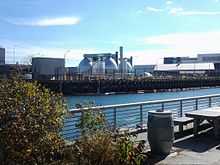Newtown Creek Wastewater Treatment Plant
Coordinates: 40°44′03″N 73°56′47″W / 40.734167°N 73.946389°W

The Newtown Creek Wastewater Treatment Plant is the largest sewage treatment facility operated by the New York City Department of Environmental Protection.[1] Since 2010, its eight metallic "digester eggs," which are 140 feet (42 meters) tall and dramatically illuminated with blue light at night, have made it a local landmark,[2] particularly to motorists on several nearby roadways in the New York City boroughs of Brooklyn, Queens, and Manhattan.[1] It is located on the Newtown Creek in Brooklyn's Greenpoint neighborhood along Greenpoint Avenue.
History
The plant was originally constructed in 1967.[3] The plant's unusual public amenities, which include a visitors' center with a manmade waterfall, a nature walk along the Newtown Creek, and the dramatic aesthetic elements, all stem from a long-term upgrade project that was begun by the city in 1998 and is scheduled for completion in 2014.[3] The aim of this work is to increase plant capacity by 50 percent and to comply with the U.S. Clean Water Act.[4] When some Greenpoint residents resisted the expansion of the plant, the city responded by appointing a group of local residents to represent the community's interests during design and construction.[1] The participation of this group, as well as a city law that requires 1 percent of expenditures on public works go to public art, led to the inclusion of the public amenities in the project plan.[4] The nature walk opened in 2007, and the other elements were all in place by 2010. The plant has remained in full operation during the renovation project.[1]
The city chose Polshek Partnership, now known as Ennead Architects LLP, as the lead architect and master planner for the renovation project. Polshek worked with three environmental engineering firms, Greeley and Hansen, Hazen and Sawyer, and Malcolm Pirnie.[1][5] Vito Acconci was engaged to create the waterfall and watercourse in and around the visitors' center.[4] Hervé Descottes was chosen to design the lighting, which includes the blue lighting of the digester eggs as well as white lighting of walkways. George Trakas designed the nature walk, which includes several sculptural elements.[6] The plant's design has won awards from the AIA, the Society of American Registered Architects, and from the Art Commission of the City of New York (now known as the NYC Design Commission).[5]
The egg-shaped structures house the plant's sludge digesters. The digesters use a process called anaerobic digestion to transform the sewage plant sludge byproduct into a form which can be used as fertilizer.[7]
Structure
The plant can handle 310 million gallons of waste water per day, with about 250 million gallons being the daily average,[4] representing about 18 percent% of the city's wastewater. It serves an area with a population of just over 1 million people in Lower Manhattan and nearby parts of Brooklyn and Queens.[8] Its site covers 54 acres[4] and is bounded by Greenpoint Avenue on the south, Provost Avenue on the west, Kingsland Avenue on the east, and Paidge Avenue and Newtown Creek on the north. An inlet called Whale Creek bisects the northern portion of the site.
The plant gives monthly public tours of the digester eggs, for which reservations are required. The Visitor Center, which is located on Greenpoint Avenue at Humboldt Street, is open by appointment only. In addition, the Visitor Center can be rented for events. Details can be found on the referenced website.[1] The Nature Walk is outside the perimeter fence of the plant and is thus open daily during daylight hours. It can be accessed from the foot of Paidge Avenue, east of its intersection with Provost Street.[6]
References
| Wikimedia Commons has media related to Newtown Creek Wastewater Treatment Plant. |
- ↑ 1.0 1.1 1.2 1.3 1.4 1.5 "Newtown Creek Wastewater Treatment Plant". New York City Department of Environmental Protection (NYCDEP). Retrieved 13 October 2013.
- ↑ "Love Stinks? Tours Of Brooklyn Sewage Treatment Plant Popular On Valentine’s Day". CBS New York.
- ↑ 3.0 3.1 Jones, Raymond McCrea. "Transforming the Sludge at Newtown Creek (slideshow)". New York Times. Retrieved 14 October 2013.
- ↑ 4.0 4.1 4.2 4.3 4.4 Leitner, David W. "Newtown Creek Digester Eggs: The Art of Human Waste". GE Focus Forward Films. Retrieved 14 October 2013.
- ↑ 5.0 5.1 "Newtown Creek". Ennead Architects LLP. Retrieved 14 October 2013.
- ↑ 6.0 6.1 "The Newtown Creek Nature Walk (flyer)". New York City Department of Environmental Protection. Retrieved 14 October 2013.
- ↑ NYCDEP. "The Newtown Creek Digester Eggs." Accessed 2014-06-06.
- ↑ "New York City's Wastewater Treatment System". New York City Department of Environmental Protection. Retrieved 14 October 2013.